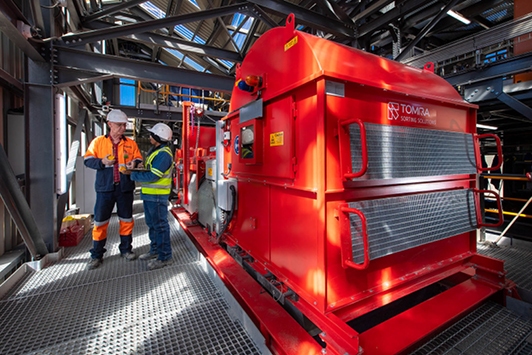 Image: Tomra
Image: TomraSorting is an important part of the diamond recovery process, and how that sorting is done can make all the difference in finding headline-worthy, multi-million-dollar stones amid the smaller and less remarkable ones. The conventional method is dense media separation (DMS), which uses gravity to sort the stones through a solution of water and mineral powder. However, in recent years, X-ray transmission (XRT) technology has started becoming the industry’s preferred option, both as a standalone choice and as a complement to DMS. XRT has proven itself to be cost-, waste- and energy-efficient for miners, helping them recover greater quantities of intact large stones.
XRT technology is analogous to an airport baggage scanner. It detects carbon at an atomic level, then ejects any carbon-based material via air jets over a splitter plate and into a concentration chute. It does this at high speeds, moving ore at approximately 3 meters per second and scanning 10,000 particles per second, according to Geoffrey Madderson, CEO and cofounder of engineering-solutions company Stark Resources, which helps clients optimize their processes. Along with speed, XRT has a high degree of accuracy and relatively low operating costs per ton, allowing miners not only to recover exceptional stones of over 20 millimeters (about 40 to 60 carats), but to do so economically.
“X-ray technology has been around for many years,” notes Anthon Voight, post-design engineering manager at De Beers Group Ignite. XRT can simplify the entire diamond recovery process, make plants more efficient, and improve diamond recovery rates, he continues, “resulting in smaller footprints, lower environmental impact and reduced operational costs, with greater return on investment.”
The many vs. The few
Prior to 2015 — when early adopters like Lucara Diamond Corp. were beginning to use XRT for primary diamond recovery — exceptionally large diamonds were typically hand-picked, like the 3,106.75-carat Cullinan and 21.25-carat Eureka rough stones from South Africa. Sorting methods at the time couldn’t economically prioritize retrieving these rare goods while remaining efficient. Since each ore body has a different distribution of diamond sizes within it, miners would calibrate the sorting process to find the sizes most likely to occur at a given mine site. In other words, the system was optimized to find the many, not the few. And because methods like DMS involve crushing the ore first, there is a greater chance of breakage, and therefore a lower chance of retrieving large stones.
However, XRT has changed this landscape, allowing for more accurate sorting across many different size ranges. “XRT offers a cost-effective mechanism for recovering large diamonds that other technologies do not provide,” Madderson states. For sizes of 25 to 30 millimeters (90 to 200 carats) or more, “DMS becomes extremely expensive to operate relative to the number of diamonds recovered. XRT solutions also have a power consumption that is up to a factor of 10 less than what DMS would be.”
Lucara uses XRT for size ranges of 4 to 100 millimeters — anywhere from 0.40 to 7,500 carats — though larger is possible, says John Armstrong, the company’s vice president of technical services. “At our Karowe mine, we have recovered three diamonds greater than 1,000 carats since 2015, all using XRT bulk sorting.” These stones include the 1,758-carat Sewelô diamond and the 1,109-carat Lesedi La Rona.
Stones greater than 10.8 carats account for some 60% to 70% of Lucara’s revenue from Karowe. The high proportion of big diamonds in the ore body makes it worthwhile for the company to use XRT over other methods.
“The strategic location of the XRT machines allows Lucara to benefit by recovering large high-value goods as soon as possible after [their removal from the ground,] decreasing the potential for value loss through damage or breakage,” Armstrong says.
The race to efficiency
The leading makers of XRT diamond-sorting systems are Germany-based Tomra — which has the lion’s share of the market and is Lucara’s provider of choice — and Steinert, although some miners use proprietary in-house technologies.
“Tomra XRT technology is advancing at a rapid pace” and can now guarantee its customers more than 98% recovery, says Ryan Szabo, the company’s sales project manager for diamonds.
The real race for XRT purveyors, though, is to find faster and more accurate ways to recover smaller stones.
“The technical challenge for XRT remains in the finer sizes for high-capacity machines as direct alternatives to conventional diamond recovery plant technologies,” says Voight. “This is an area of ongoing, focused R&D.”
It’s also been the main focus of XRT companies’ marketing. Tomra boasts that it can sort goods as small as 2 millimeters (about 0.05 carats). For Madderson, however, it’s the broader potential of improved diamond recovery that’s of greater interest to the supply chain. “It is not about pushing as much as possible through an ore sorter. Clients want effective ways of recovering all diamond types and increasing their overall recovery performance.”
Fewer broken diamonds means the miner gets more value from the ore deposit, he explains. And “the higher the revenue of the mining company, the more taxes they pay, and the more the country can reinvest into its people and infrastructure.”
As such, XRT technology is not just changing the landscape of diamond recovery, but rippling outward to add value to the entire supply chain.
Article from the Rapaport Magazine - June 2022. To subscribe click here.